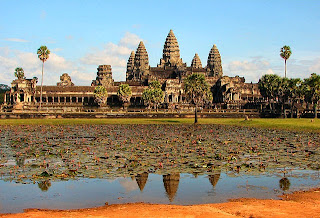Angkor Wat was once the largest Hindu temple in the 12th century. It
later turned into a Buddhist temple and is now the largest religious
monument in the world as well as one of the most important
archaeological sites in South-East Asia. This incredible structure is
made out of over 5 million tons of sandstone and every aspect of the
exterior and interior is hand carved including gorgeous illustrations
from ancient Indian texts.
Built in the early 1100′s by the Khmer King Suryavarman II, the
temples at Angkor represent one of the most advanced architectural
achievements in relation to its time.
The temple was originally dedicated to the Hindu god, Vishnu, but later became a site for practitioners of Buddhism. Today, the site is a major tourist location, pulling in upwards of 600,000 foreigners every year. Efforts to preserve and restore the temple have been ongoing since the 1980’s and various countries have made efforts to protect the site including, the U.S., France, Germany, and Japan.
The temple was originally dedicated to the Hindu god, Vishnu, but later became a site for practitioners of Buddhism. Today, the site is a major tourist location, pulling in upwards of 600,000 foreigners every year. Efforts to preserve and restore the temple have been ongoing since the 1980’s and various countries have made efforts to protect the site including, the U.S., France, Germany, and Japan.
Conflicting theories exist in relation to the temple’s purpose.
Unlike most of the other temples in the area, Angkor Wat’s main entrance
faces westward. This has led some historians to believe that the temple
was actually built as a funerary site for Suryavarman II. However,
others reason that the temple faces west because the Hindu god, Veshnu,
was affiliated with that direction. Regardless of the site’s purpose,
though, it is agreed that Angkor Wat was once one of the largest cities
in the world, and that it combined secularism and spiritualism.
Angkor Wat was built early in 1100s by Suryavarman II over an
estimated 30 year period. It honors Vishnu, and the ruins are a symbolic
structure of Hindu cosmology. The temple is located about 4 miles to
the north of Siem Reap and south of Angkor Thom, its only accessible
entrance through the gate to the west.
Angkor Wat is one of the largest religious sites in the world,
covering around 500 acres of land. Its five walls and moats are a
representation of mountainous chains, as well as the cosmic ocean. The
vast compound’s short dimensions are aligned precisely along the
north-south axis, and the east to west axis was diverted deliberately
0.75° to give its observers an anticipation of the equinox in spring for
three days.
{GMST}13|25.53600|N|103|51.60000|E|Angkor Wat Temple|Angkor Wat Temple{GEND}
Thankyou for reading the article Angkor Wat Temple – Krong Siem Reap, Cambodia on my blog touristions

France is packed full of fantastic attractions to visit. From the romance of Paris to the sunshine…
ReplyDelete